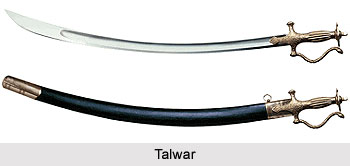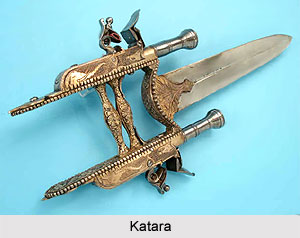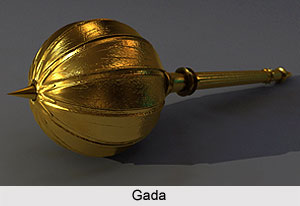 Ancient Indian Weapons such as the spear, the bow and arrow, maces, swords, axes, spears, shields and others were widely used during the ancient and medieval ages in India. Many more weapons and armaments were developed later on by the Indian army, scattered through various regions and cultures that existed during those periods. Other types of ancient Indian weapons are the sling, falx, javelin, clubs, knives, catapults, battering rams, cannons, siege towers, which were primarily implemented during sieges. A wide range of weapons are found in India and some of them are unique to the region. During the ancient periods, Indian army used standard weapons like swords, wooden or metal tipped spears, wooden or metal shields, thatched bamboo, short and long bows and axes in combats, even as early as the 4th century BC.
Ancient Indian Weapons such as the spear, the bow and arrow, maces, swords, axes, spears, shields and others were widely used during the ancient and medieval ages in India. Many more weapons and armaments were developed later on by the Indian army, scattered through various regions and cultures that existed during those periods. Other types of ancient Indian weapons are the sling, falx, javelin, clubs, knives, catapults, battering rams, cannons, siege towers, which were primarily implemented during sieges. A wide range of weapons are found in India and some of them are unique to the region. During the ancient periods, Indian army used standard weapons like swords, wooden or metal tipped spears, wooden or metal shields, thatched bamboo, short and long bows and axes in combats, even as early as the 4th century BC.
According to the military accounts obtained from the Gupta Empire, it can be ascertained that more than one hundred and thirty different weapons were developed and segregated into thrown and un-thrown weapons classes. These are further categorised into various sub-classes. Gradually the more effective weaponry evolved in the country. More refined and complicated weapons and artillery were employed by the various armies of India. Ancient Hindu mythology and epics like Puranas, Ramayana, and Mahabharata also mentions different types of weapons that were used in warfare. Although many of them were divine weapons some resembles weapons that were used in ancient and medieval period.
Some of the most effective and well known ancient Indian weapons are discussed below-
Talwar
Indian Swords and daggers consist of a wide variety of shapes and were ornamented with priceless gems, gold and silver. The Talwar is a type of curved Indian sword or saber that gained widespread popularity during the Mughal rule. The archetypal talwar has a wide blade and does not contain an expanded false edge or yelman, like in the kilij. The pommel of the Talwar has a short spike that projects from its core, which is sometimes pierced for a cord to lock the sword to the wrist. The talwar`s grip is confined and the outstanding disc of the pommel presses into the wrist. The Indian talwar was widely utilised by both infantry and cavalry.
Pata
The Pata, also known as Patta or Dand Patta, is a variant of Indian sword that has a gauntlet which is incorporated as a hand-guard. Customarily the Maratha warriors were given combat training to fight with dual patas with one sword in each hand. Sometimes a single pata was utilized and paired with a javelin, belt or axe in the other hand.
Bagh Nakh
Bagh Nakh, also known as Wagh Nakh is an Indian weapon that has a claw-like appearance, which is designed to be concealed under the palm or to fit over the knuckles. Bagh Nakh consists of 4 or 5 different curved blades which are fixed to a glove or crossbar. The weapon is mainly designed to slice through skin and muscle of the enemy. It is considered that the design of the weapon was inspired by the tiger`s claw and the name is also derived from there as well.
Khanda
The Khanda is a double edged straight sword that was developed in India. The deadly weapon was designed by the Rajputs, but was later developed by the Sikhs, Jats and Marathas. The blade of Khanda is typically broad and rather heavy, which widens from the hilt to the slant tip. The hilt comprises of a small metal spike which comes out in the opposite direction.
 Katara
Katara
The Katara is also known as Suwaiya. It is a variant of an Indian push dagger. Katara is characterised by its typical H-shaped horizontal hand grip and as a result the blade of the sword is situated above the knuckles of the user. It is the most popular and characteristic of Indian daggers. The weapon was also used in worship.
Urumi
The Urumi is another type of Indian long sword which is constructed of flexible steel that is sharp enough to slice and pierce into flesh and flexible enough to be rolled into a tight coil. The weapon was developed in South India.
 Gada
Gada
Gada is a form of Indian mace which is mainly a blunt weapon that contains a heavy top on one end of the handle to deliver powerful blows and crush the enemy. The head of a Gada is radially symmetric therefore the blow is delivered just as effectively with any of the sides of the top head. The strong heavy handle is usually made of metal or wood and the head is constructed of stone, iron, bronze, steel or copper. The usage Gada is mentioned in the ancient Indian Sanskrit epics the Ramayana and the Mahabharata.
Aruval
Aruval is a type of billhook machete that was popularly used in warfare in southern part of India. It resembles the shape of a long sickle and comes with a knife-like scythe-handle. Aruval is used both as an agricultural tool and a weapon.
Bhuj
Originated in the regions of Sindh and Gujarat, this ancient weapon resembles a knife or a dagger. As the blade of the weapon is fixed onto an axe-like haft, it is also called Axe-knife. It is named after a place called Bhuj situated in Kutch district of Gujarat.
Bow and Arrow
Bow and Arrow, one of the most popular weapons in ancient warfare, is a crossbow-type weapon used to shoot arrows, requiring both hands for operation.
Bichuwa
Bichuwa is a dagger with a loop hilt and a narrow undulating sharp blade. It resembles the sting of a scorpion and is named after the Hindi word for scorpion, "bichuwa." Based on the maduvu or horn dagger from South India, many bichuwa blades retain the shape of buffalo horns.
Chakram
Chakram is a circular throwing weapon with a sharpened outer edge. It is also known as chalikar, meaning "circle," and was sometimes referred to as a "war-quoit" in English writings.
Chentu
Chentu, a horse whip resembling a crooked stick, is a typical attribute of Aiyanar, Krishna in his aspect as Rajagopala, and Shiva with Nandi.
Elephant goad
Elephant goad, bullhook, or ankus, is a tool used by mahouts to handle and train elephants. It consists of a hook attached to a handle, ending in a tapered point.
Khatvanga
Khatvanga, a long studded club originally created as a weapon, has been adopted as a traditional religious symbol in Indian religions such as Tantric traditions like Shaivism and Vajrayana Buddhism.
Parashu
Parashu, the Sanskrit word for a battle-axe, can be wielded with one or both hands. The parashu can have a double-edged blade or a single-edged blade with a spike on the non-cutting edge.
Apart from the above mentioned weapons, there were numerous other forms of weapons and artillery that were used in the ancient India, most of the Ancient Indian Weapons have been developed in the modern age and are still used by the Indian Army.



















